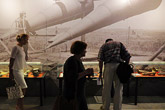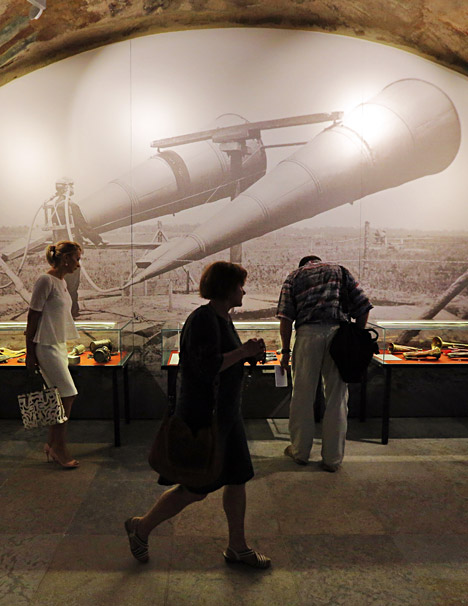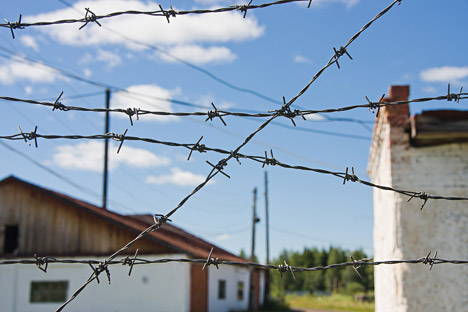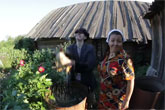First World War I museum in Russia opens near St. Petersburg


Source: ITAR-TASS
The first museum in Russia dedicated entirely to Russia’s participation in the First World War has opened in Tsarskoye Selo (Pushkin), just outside St. Petersburg. Three years and 292,000,000 rubles ($8 million) were spent on the restoration of the town’s Martial Chamber, which now houses an exhibition titled ‘Russia in the Great War’.
The history of the museum has its roots in the time of the last Russian tsar, Nicholas the Second. In 1911, during the celebration of the bicentennial of Tsarskoye Selo, the imperial family’s country residence, Nicholas II received a priceless gift – a collection of prints, paintings, icons, and maps that told the story of the military history of Russia since ancient times.
This gift was presented to the emperor by Yelena Tretyakova, the widow of the brother of the creator of the famous Tretyakov Gallery in Moscow. Nicholas was greatly pleased by the gift and gave an order for a special building to be constructed for the Military Archive of Russia, a museum to the country’s military glory. Tretyakova donated her own money for the construction of the Martial Chamber.
From the first days of Russia’s participation in the First World War, trophies began to arrive from the front that would later make up the majority of the museum’s collection. It was therefore decided to rename the museum the Museum of the Great War.
The sovereign’s Martial Chamber was completed in early 1917 but in 1918 it was closed down by the Bolsheviks. “It is difficult to imagine how Tretyakova may have felt. She had spent almost her whole life bringing together the collection and a large part of her fortune on the construction of the museum that lasted all of a year,” says Olga Taratynova, the director of the Tsarskoye Selo Museum Preserve, “and no one knows what happened to her after that. She just disappeared.”
The Martial Chamber building was returned to the Tsarskoye Selo Museum Preserve only in 2010 and it was immediately decided to restore it and re-open the Museum of the Great War.
Planes, uniforms, and a sentimental telegram
The centerpiece of the museum exhibition is a model of a French Nieuport-17 fighter airplane attached to the ceiling. The plane was used extensively in World War I. Worn frescos that were found under a layer of plaster during the restoration are visible on the vaulted ceiling.
.jpg)
Source: ITAR-TASS
The collection includes a host of military uniforms, photographs, weapons, and items used in military life, as well as all kinds of documents. “Costumes are the most attractive part of any museum’s exhibition,” says Alexei Rogatnev, a senior researcher at the Tsarskoye Selo Museum Preserve. “They are not two-dimensional images but three-dimensional objects that attract visitors’ attention. Costumes convey the atmosphere of the time, of the military life, very well.”
The military uniforms belonging to members of the imperial family, each of whom had his own subordinate regiment of about 4,000 soldiers, are showcased in one of the halls.
The museum houses a great rarity – the standard of tsarist Russia, a black, yellow, and white flag. The fact is that keeping this banner was punishable by execution until the end of World War II, so very few crested flags have survived down to this day.
On a small screen attached to the wall there is a piece of correspondence between Nicholas II and Wilhelm II – a telegram sent shortly before the outbreak of hostilities in which the Russian Tsar requested the German Kaiser to prevent the impending war, signing “Niki” to remind him of the friendship binding them. For now, only Russian speakers will be able to read the telegram – the captions and historical information in the museum, displayed on large sensory monitors, are currently only in Russian. The English versions will be ready within the next six months.
A frying pan to ward off a bullet
Among the items displayed is a regular cast iron skillet; pilots used to place them under their seats in order to protect themselves from bullets. There are photographs of dogs and horses in gas masks as well as the gas masks themselves, which were developed in Russia just in time for World War I by scientist Nikolai Zelinsky.
There is even a genuine Ford automobile from the time of the war – an exclusive model of the Ford Model T produced by the American Ford Motor Company from 1908 to 1927. Wear and tear over the years mean that few examples of this model have survived to the present day.
In the early 20th century, a new type of troops appeared in the Russian army – motorized troops. At the time of the start of the First World War, the army had five automobile companies and six separate road teams (for servicing the light auto transport of the staff and institutions of the Military Department) and one training company.
There were supposed to have been two automobile companies and a motorcycle division in the army, and the same number of automobile companies was to have been kept in the front's reserve. In the service of the Russian army there were trucks and medical and staff vehicles produced by the Ford Motor Company.
By November 1917, the Russian army already had 22 separate automobile companies and nearly 10,000 automobiles. The composition of the one displayed in the exhibition suggests that it was produced no earlier than 1908 and no later than 1914.
There are also portraits of the Knights of the Order of St. George on show in the Martial Chamber. The highest military decoration in the Russian Empire, the Order of St. George accepted not only noblemen but also ordinary soldiers for their courage and valor. It was during the First World War that the term "mass heroism" was first conceived in Russia, and the Order of St. George was awarded so often that votes had to be taken within a regiment on whose portrait should be in the gallery.
Meanwhile, one and a half million Russians were awarded the Cross of St. George (the medal for military merit and bravery for the lower ranks) during World War I.
Museum address: 5A Fermskaya Street, Pushkin (Tsarskoye Selo), St. Petersburg.
All rights reserved by Rossiyskaya Gazeta.
Subscribe
to our newsletter!
Get the week's best stories straight to your inbox


